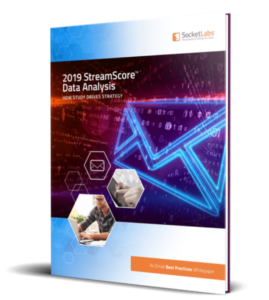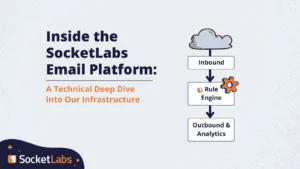This blog is Part 1 of our StreamScore™ data analysis case study (Find Part 2 here). If you are new to StreamScore™ , check out our StreamScore™ homepage.
Case Studies with Aggregate Scores of 65-75
Knowing a client’s overall StreamScore™ is a good place to start when looking to improve email deliverability. However, seeing how their StreamScore™ is comprised – i.e. by looking at the underlying components – is what creates real value fo r clients who want to implement operational improvements to optimize their email performance. The component-level detail is deeply instructive regarding where and how to hone their deliverability results. More specifically, reviewing underperforming StreamScore™ components allows clients to scrutinize the key variables that they control, and that they can modify to improve mailing outcomes. For example, clients may learn that they need to improve:
r clients who want to implement operational improvements to optimize their email performance. The component-level detail is deeply instructive regarding where and how to hone their deliverability results. More specifically, reviewing underperforming StreamScore™ components allows clients to scrutinize the key variables that they control, and that they can modify to improve mailing outcomes. For example, clients may learn that they need to improve:
- The quality of their email lists
- The nature and style of message content, and
- The reaction of recipients to their messages
- The degree to which their organizations follow “email best practices”
- The degree to which the combination of content and list quality leads recipients to engage with the client’s content
To illustrate how this works in practice, we analyzed a variety of clients across 4 different tiers of overall StreamScores. We published this information in our whitepaper: Improving Email Performance with Data. This blog is a subset of the whitepaper which looks at 2 groups of recommendations for low performing companies (those with an overall score of 65 and those with an overall score of 75). A subsequent blog article looks at the recommendations we mad for higher performers (those with aggregate scores of 85 and 95).
The data reveals how no two clients are alike and how even those with similar overall scores can have widely different needs. Keep in mind that these scores represent only one of potentially many mail streams for each sending organization. For most, there are many addition streams, serving different operational purposes, which a client is managing simultaneously. Also, each set of StreamScore™ data is captured at a “specific point in time” which reflects the senders’ mailing volume and circumstances averaged over a 15-day time window only. Depending on those circumstances, the diagnosis, and the sender’s willingness to make adjustments, the scores can be improved rapidly. The dynamic nature of the client’s StreamScore™ is what makes it so important that an active management approach is taken.
Group 1: StreamScore™ of 65
The companies in this group includes 3 sending transactional messages and one which is sending marketing messages. One is a financial services company, one is a retailer, one is a CRM software vendor, and one is a digital marketing agency.
Case 1 – Financial Services Company
Observation
Very low block score and weak hard fail score. No complaint data is available.
Cause Analysis
This company sends email on behalf of other well-known organizations who are “frequently spoofed”. This fact leads to greater filtering scrutiny by mailbox providers to prevent spoofing.
Recommendation
Authentication protocols such as SPF and DKIM should be applied to help legitimize the messages in the eyes of email filtering tools.
Case 2 – Retail Company
Observation
High Hard Fail Score due to list quality.
Cause Analysis
The sender is not performing list hygiene.
Recommendation
Ensure that former customer names and invalid addresses or typos are identified and removed.
Case 3- CRM Software Company
Observation
High Spam rate due to a domain reputation issue.
Cause Analysis
The sender historically used poor email practices that have resulted in blacklisted IPs and a poor domain reputation.
Recommendation
Adopting new best practices will rebuild their reputation over time and increase delivery.
Case 4- Digital Marketing Company
Observation
Primary concern is a very poor Block Score.
Cause Analysis
High compliant rates are being caused by unwanted transactional messages resulting from technical holes in the sender’s website. The subscription feature on their website allowed “subscription bombing” – where bots automatically register in high volumes using random people’s email addresses.
Recommendation
We’ve advised client how to close web loophole and remove the unintended addresses.
Group 2: StreamScore™ of 75
The companies in this group includes 2 sending transactional messages, 2 sending marketing messages, and one smart hosting client sending person-to-person email.
Case 1 – Digital Marketing Company
Observation
High percentage of blocked messages causing a score of “0”.
Cause Analysis
Blocking is due to early campaign recipients indicating mail as “spam”. report happens by early recipients. Filters are currently blocking new messages as a result.
Recommendation
Make changes to the list acquisition process to get opt-in permission, set recipient expectations, and content that’s desired.
Case 2 – IT Services Company
Observation
Weak block score. No complaint data is available.
Cause Analysis
The client is not authenticating their email and anti-spoofing filters are questioning the legitimacy of the messages.
Recommendation
Apply SPF and DKIM authentication. Consider benefits of defining a DMARC policy.
Case 3- Digital Marketing Company
Observation
No Block Score due to a very high block rate. Complaint Score is strong.
Cause Analysis
This is an email policy issue. Email is being sent to many students at .edu addresses that have filters set very high and block most unrecognized incoming mail. The mail content is relevant and of high quality.
Recommendation
Identify alternate addresses and/or petition specific school domains to — authentication may help.
Case 4- SaaS Company
Observation
Poor block score and low spam score.
Cause Analysis
This is a well-known software brand that is hitting spam traps because of how loosely email addresses are collected for free trials. Addresses are not forced to be valid when entered. Consequently, the feedback surveys they send to anyone on the list contain many errors that go to the wrong people. Complaints are coming from random unintended recipients of the surveys causing reputation damage, domain damage, and blocked messages.
Recommendation
The client would benefit greatly from enforcing email validation on their website in the user sign up process.
Case 5: Healthcare Company
Observation
Poor Complaint Score on person-to-person email.
Cause Analysis
Client mail has been moved to spam by many recipients.
Recommendation
Separate streams of B2B mail from B2C mail and establish more clear expectations among list members that they will receive subsequent communications.
>>Continue on to Part 2 of our StreamScore™ Data Analysis case studies or return to our StreamScore™ homepage.







